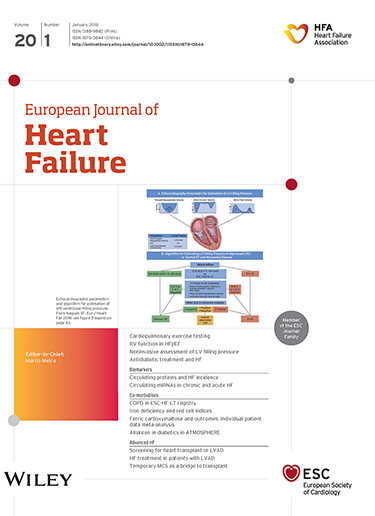Ferric derisomaltose augments intrinsic skeletal muscle electron transport chain activity in heart failure: A FERRIC-HF II molecular substudy.
IF 10.8
1区 医学
Q1 CARDIAC & CARDIOVASCULAR SYSTEMS
引用次数: 0
Abstract
AIMS Skeletal muscle energetic augmentation might be a mechanism via which intravenous iron improves symptoms in heart failure, but no direct measurement of intrinsic mitochondrial function has been performed to support this notion. This molecular substudy of the FERRIC-HF II trial tested the hypothesis that ferric derisomaltose (FDI) would improve electron transport chain activity, given its high dependence on iron-sulfur clusters which facilitate electron transfer during oxidative phosphorylation. METHODS AND RESULTS Vastus lateralis skeletal muscle biopsies were taken before and 2 weeks after randomization. Mitochondrial complex I, II, and I&II respiration were quantified with respirometry of permeabilized fresh skeletal muscle biopsies. Net respiratory capacities, reflecting respiration that is truly available for adenosine triphosphate generation, were calculated by subtracting non-phosphorylating LEAK respiration. Complex I-V and myoglobin protein levels, and skeletal muscle fibre type composition were assayed. Patients randomised to FDI (n = 21) or placebo (n = 19) were similar (age 66 ± 13 years, 73% men, left ventricular ejection fraction 37 ± 8%, 48% New York Heart Association class III, 50% diabetic). After 2 weeks, total complex I-linked respiration (0.33 [interquartile range 0.24-0.37] vs. 0.19 [0.06-0.27] nmol/min/mg, p = 0.03) and net complex I-linked respiration (0.21 [0.16-0.24] vs. 0.11 [0.04-0.16] nmol/min/mg, p = 0.01) were higher in patients allocated to FDI. There was no intergroup difference in other respiratory states, in mitochondrial abundance as reflected by complex I-V protein levels, and in skeletal muscle myoglobin and oxidative fibre type content. CONCLUSIONS Iron repletion induces an early, selective, and potentially direct enhancement of mitochondrial complex I-dependent respiration in the skeletal muscle of heart failure patients. This could be harnessed to optimize repletion protocols to maximize patient benefits.脱异麦芽糖铁增强心力衰竭内在骨骼肌电子传递链活性:一项Ferric - hf II分子亚研究。
骨骼肌能量增强可能是静脉注射铁改善心力衰竭症状的一种机制,但没有对内在线粒体功能的直接测量来支持这一观点。ferric - hf II试验的分子亚研究验证了这样的假设:考虑到铁硫团簇在氧化磷酸化过程中促进电子转移的高度依赖,二异麦芽糖铁(FDI)会提高电子传递链的活性。方法与结果随机分组前和随机分组后2周分别行股外侧骨骼肌活检。线粒体复合体I、II和I&II呼吸用透性新鲜骨骼肌活检呼吸测定法定量。净呼吸能力,反映呼吸真正可用于三磷酸腺苷的产生,通过减去非磷酸化的LEAK呼吸来计算。测定复合体I-V和肌红蛋白水平,以及骨骼肌纤维类型组成。随机分配到FDI组(n = 21)或安慰剂组(n = 19)的患者相似(年龄66±13岁,73%为男性,左室射血分数37±8%,48%为纽约心脏协会III级,50%为糖尿病)。2周后,分配到FDI的患者的总复合i联呼吸(0.33[四分位数间距0.24-0.37]比0.19 [0.06-0.27]nmol/min/mg, p = 0.03)和净复合i联呼吸(0.21[0.16-0.24]比0.11 [0.04-0.16]nmol/min/mg, p = 0.01)更高。其他呼吸状态、复合体I-V蛋白水平反映的线粒体丰度、骨骼肌肌红蛋白和氧化纤维类型含量在组间无差异。结论:在心力衰竭患者的骨骼肌中,铁离子补充可诱导线粒体复合体i依赖性呼吸的早期、选择性和潜在的直接增强。这可以用来优化补充方案,以最大限度地提高患者的利益。
本文章由计算机程序翻译,如有差异,请以英文原文为准。
求助全文
约1分钟内获得全文
求助全文
来源期刊

European Journal of Heart Failure
医学-心血管系统
CiteScore
27.30
自引率
11.50%
发文量
365
审稿时长
1 months
期刊介绍:
European Journal of Heart Failure is an international journal dedicated to advancing knowledge in the field of heart failure management. The journal publishes reviews and editorials aimed at improving understanding, prevention, investigation, and treatment of heart failure. It covers various disciplines such as molecular and cellular biology, pathology, physiology, electrophysiology, pharmacology, clinical sciences, social sciences, and population sciences. The journal welcomes submissions of manuscripts on basic, clinical, and population sciences, as well as original contributions on nursing, care of the elderly, primary care, health economics, and other related specialist fields. It is published monthly and has a readership that includes cardiologists, emergency room physicians, intensivists, internists, general physicians, cardiac nurses, diabetologists, epidemiologists, basic scientists focusing on cardiovascular research, and those working in rehabilitation. The journal is abstracted and indexed in various databases such as Academic Search, Embase, MEDLINE/PubMed, and Science Citation Index.
 求助内容:
求助内容: 应助结果提醒方式:
应助结果提醒方式:


